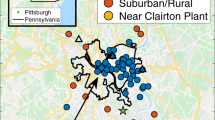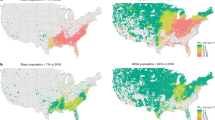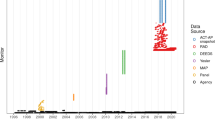Abstract
Background
Low-cost sensors have the potential to democratize air pollution information and supplement regulatory networks. However, differentials in access to these sensors could exacerbate existing inequalities in the ability of different communities to respond to the threat of air pollution.
Objective
Our goal was to analyze patterns of deployments of a commonly used low-cost sensor, as a function of demographics and pollutant concentrations.
Methods
We used Wilcoxon rank sum tests to assess differences between socioeconomic characteristics and PM2.5 concentrations of locations with low-cost sensors and those with regulatory monitors. We used Kolomogorov–Smirnov tests to examine how representative census tracts with sensors were of the United States. We analyzed predictors of the presence, and number of, sensors in a tract using regressions.
Results
Census tracts with low-cost sensors were higher income more White and more educated than the US as a whole and than tracts with regulatory monitors. For all states except for California they are in locations with lower annual-average PM2.5 concentrations than regulatory monitors. The existing presence of a regulatory monitor, the percentage of people living above the poverty line and PM2.5 concentrations were associated with the presence of low-cost sensors in a tract.
Significance
Strategies to improve access to low-cost sensors in less-privileged communities are needed to democratize air pollution data.
This is a preview of subscription content, access via your institution
Access options
Subscribe to this journal
Receive 6 print issues and online access
$259.00 per year
only $43.17 per issue
Buy this article
- Purchase on Springer Link
- Instant access to full article PDF
Prices may be subject to local taxes which are calculated during checkout


Similar content being viewed by others
References
US EPANAAQS Table . https://www.epa.gov/criteria-air-pollutants/naaqs-Table
Sullivan DM, Krupnick A. Using Satellite Data to Fill the Gaps in the US Air Pollution Monitoring Network. Resour Future Work Pap. 2018;18–21.
Watson JG, Chow JC, DuBois D, Green M, Frank N. Guidance for the network design and optimum site exposure for PM2. 5 and PM10 (No. PB-99-157513/XAB; EPA-454/R-99/022). Environmental Protection Agency, Office of Air Quality Planning and Standards, Research Triangle Park, NC (United States); Nevada Univ. System, Desert Research Inst., Reno, NV (United States); National Oceanic and Atmospheric Administration, Las Vegas, NV (United States). 1997.
Grainger C, Schreiber A, Chang W. Do regulators strategically avoid pollution hotspots when siting monitors? Evidence from remote sensing of air pollution. University of Wisconsin. 2018. unpublished manuscript.
Grainger C, Schreiber A. Discrimination in ambient air pollution monitoring? AEA Pap Proc. 2019;109:277–82.
Muller NZ, Ruud PA. What forces dictate the design of pollution monitoring networks? Environ Model Assess. 2018;23:1–14.
Zou E. Unwatched pollution: the effect of intermittent monitoring on air quality. 2018. https://static1.squarespace.com/static/56034c20e4b047f1e0c1bfca/t/5b8a0680758d4634c2df5867/1535772291252/monitor_zou_201808.pdf.
Williams R, Kilaru V, Snyder E, Kaufman A, Dye T, Rutter A, et al. Air Sensor Guidebook. Washington, DC.: US Environmental Protection Agency; 2014. EPA/600/R-14/159 (NTIS PB2015-100610).
Snyder EG, Watkins TH, Solomon PA, Thoma ED, Williams RW, Hagler GSW, et al. The changing paradigm of air pollution monitoring. Environ Sci Technol. 2013;47:11369–77.
deSouza P, Nthusi V, Klopp JM, Shaw BE, Ho WO, Saffell J, et al. A Nairobi experiment in using low cost air quality monitors. Clean Air J Tydskr Vir Skoon Lug. 2017;27:12–42.
deSouza P, Anjomshoaa A, Duarte F, Kahn R, Kumar P, Ratti C. Air quality monitoring using mobile low-cost sensors mounted on trash-trucks: methods development and lessons learned. Sustain Cities Soc. 2020;60:102239.
deSouza P, Kahn RA, Limbacher JA, Marais EA, Duarte F, Ratti C. Combining low-cost, surface-based aerosol monitors with size-resolved satellite data for air quality applications. Atmos Meas Tech. 2020;13:5319–34.
Castell N, Dauge FR, Schneider P, Vogt M, Lerner U, Fishbain B, et al. Can commercial low-cost sensor platforms contribute to air quality monitoring and exposure estimates? Environ Int. 2017;99:293–302.
Clements AL, Griswold WG, Rs A, Johnston JE, Herting MM, Thorson J, et al. Low-cost air quality monitoring tools: from research to practice (a workshop summary). Sensors. 2017;17:2478.
Kumar P, Morawska L, Martani C, Biskos G, Neophytou M, Di Sabatino S, et al. The rise of low-cost sensing for managing air pollution in cities. Environ Int. 2015;75:199–205.
Morawska L, Thai PK, Liu X, Asumadu-Sakyi A, Ayoko G, Bartonova A, et al. Applications of low-cost sensing technologies for air quality monitoring and exposure assessment: How far have they gone? Environ Int. 2018;116:286–99.
McKercher GR, Salmond JA, Vanos JK. Characteristics and applications of small, portable gaseous air pollution monitors. Environ Pollut. 2017;223:102–10.
O’Rourke D, Macey GP. Community environmental policing: Assessing new strategies of public participation in environmental regulation. J Policy Anal Manag. 2003;22:383–414.
Williams R, Duvall R, Kilaru V, Hagler G, Hassinger L, Benedict K, et al. Deliberating performance targets workshop: potential paths for emerging PM2.5 and O3 air sensor progress. Atmos Environ X. 2019;2:100031.
English PB, Richardson MJ, Garzón-Galvis C. From crowdsourcing to extreme citizen science: participatory research for environmental health. Annu Rev Public Health. 2018;39:335–50.
Community Air Protection Program | California Air Resources Board. Accessed 12 Oct 2020. https://ww2.arb.ca.gov/capp
Austen K. Environmental science: pollution patrol. Nat N. 2015;517:136.
Hubbell BJ, Kaufman A, Rivers L, Schulte K, Hagler G, Clougherty J, et al. Understanding social and behavioral drivers and impacts of air quality sensor use. Sci Total Environ. 2018;621:886–94.
Ottinger G. Buckets of resistance: standards and the effectiveness of citizen science. Sci Technol Hum Values. 2010;35:244–70.
Allen BL. Uneasy alchemy: citizens and experts in Louisiana’s chemical corridor disputes. MIT Press: Cambridge MA; 2003.
Bell ML, Ebisu K. Environmental inequality in exposures to airborne particulate matter components in the United States. Environ Health Perspect. 2012;120:1699–1704.
Miranda ML, Edwards SE, Keating MH, Paul CJ. Making the environmental justice grade: the relative burden of air pollution exposure in the United States. Int J Environ Res. Public Health. 2011;8:1755–71.
Sayahi T, Kaufman D, Becnel T, Kaur K, Butterfield AE, Collingwood S, et al. Development of a calibration chamber to evaluate the performance of low-cost particulate matter sensors. Environ Pollut. 2019;255:113131.
PurpleAir PA-II. Accessed 27 Jun 2020. https://www.aqmd.gov/aq-spec/product/purpleair-pa-ii
Kelly KE, Whitaker J, Petty A, Widmer C, Dybwad A, Sleeth D, et al. Ambient and laboratory evaluation of a low-cost particulate matter sensor. Environ Pollut. 2017;221:491–500.
Badura M, Batog P, Drzeniecka-Osiadacz A, Modzel P. Evaluation of Low-Cost Sensors for Ambient PM2.5 Monitoring. Vol. 2018, Journal of Sensors. Hindawi; 2018. Accessed 27 Sep 2020. p. e5096540. https://www.hindawi.com/journals/js/2018/5096540/
Liu X, Jayaratne R, Thai P, Kuhn T, Zing I, Christensen B, et al. Low-cost sensors as an alternative for long-term air quality monitoring. Environ Res. 2020;185:109438.
Glenn EH, ACS.R, An R Package for Neighborhood-Level Data from the U.S. Census. Rochester, NY: Social Science Research Network; 2011. Accessed 27 Jun 2020. Report No.: ID 2171390. https://papers.ssrn.com/abstract=2171390
Auchincloss Amy H, Diez Roux Ana V, Timothy Dvonch J, Brown Patrick L, Barr Graham R, Daviglus Martha L. et al. Associations between recent exposure to ambient fine particulate matter and blood pressure in the multi-ethnic study of atherosclerosis (MESA). Environ Health Perspect. 2008;116:486–91.
van Donkelaar A, Martin RV, Li C, Burnett RT. Regional estimates of chemical composition of fine particulate matter using a combined geoscience-statistical method with information from satellites, models, and monitors. Environ Sci Technol. 2019;53:2595–611.
Team RC, others. R: A language and environment for statistical computing. Vienna, Austria; 2013.
Gupta P, Doraiswamy P, Levy R, Pikelnaya O, Maibach J, Feenstra B, et al. Impact of California fires on local and regional air quality: the role of a low-cost sensor network and satellite observations. GeoHealth. 2018;2:172–81.
Bi J, Wildani A, Chang HH, Liu Y. Incorporating low-cost sensor measurements into high-resolution PM2.5 modeling at a large spatial scale. Environ Sci Technol. 2020;54:2152–62.
Acknowledgements
This research did not receive any specific grant from funding agencies in the public, commercial, or not-for-profit sectors. The authors are grateful to Mariana Arcaya and R. Subramanian for several useful discussions.
Author information
Authors and Affiliations
Corresponding author
Ethics declarations
Conflict of interest
The authors declare no competing interests.
Additional information
Publisher’s note Springer Nature remains neutral with regard to jurisdictional claims in published maps and institutional affiliations.
Supplementary Information
Rights and permissions
About this article
Cite this article
deSouza, P., Kinney, P.L. On the distribution of low-cost PM2.5 sensors in the US: demographic and air quality associations. J Expo Sci Environ Epidemiol 31, 514–524 (2021). https://doi.org/10.1038/s41370-021-00328-2
Received:
Revised:
Accepted:
Published:
Issue Date:
DOI: https://doi.org/10.1038/s41370-021-00328-2
Keywords
This article is cited by
-
Representativeness of the US EPA PM monitoring site locations to the US population: implications for air pollution prediction modeling
Journal of Exposure Science & Environmental Epidemiology (2024)
-
Local exposure misclassification in national models: relationships with urban infrastructure and demographics
Journal of Exposure Science & Environmental Epidemiology (2023)
-
Exposures and behavioural responses to wildfire smoke
Nature Human Behaviour (2022)
-
Using crowd-sourced low-cost sensors in a land use regression of PM2.5 in 6 US cities
Air Quality, Atmosphere & Health (2022)



